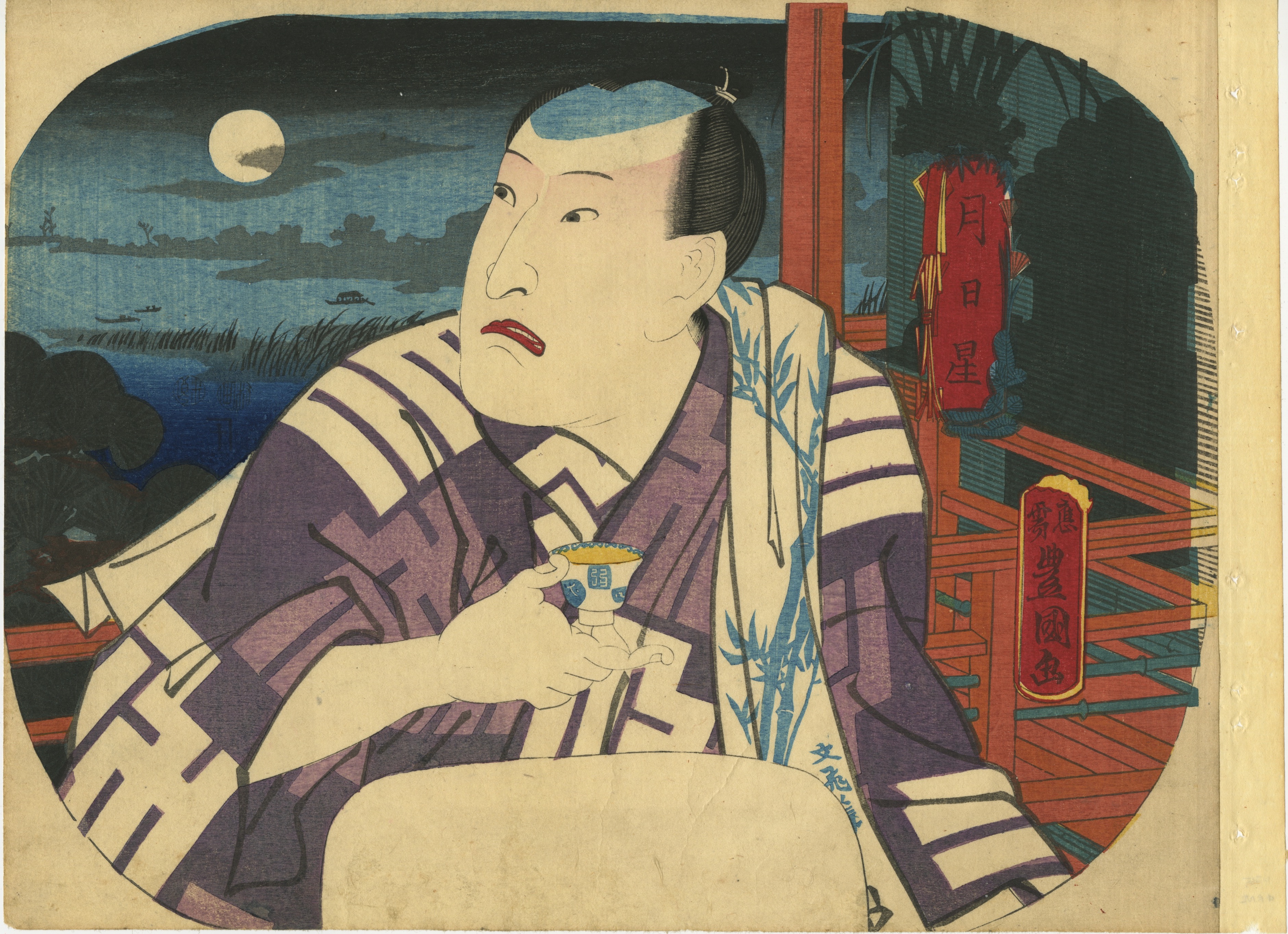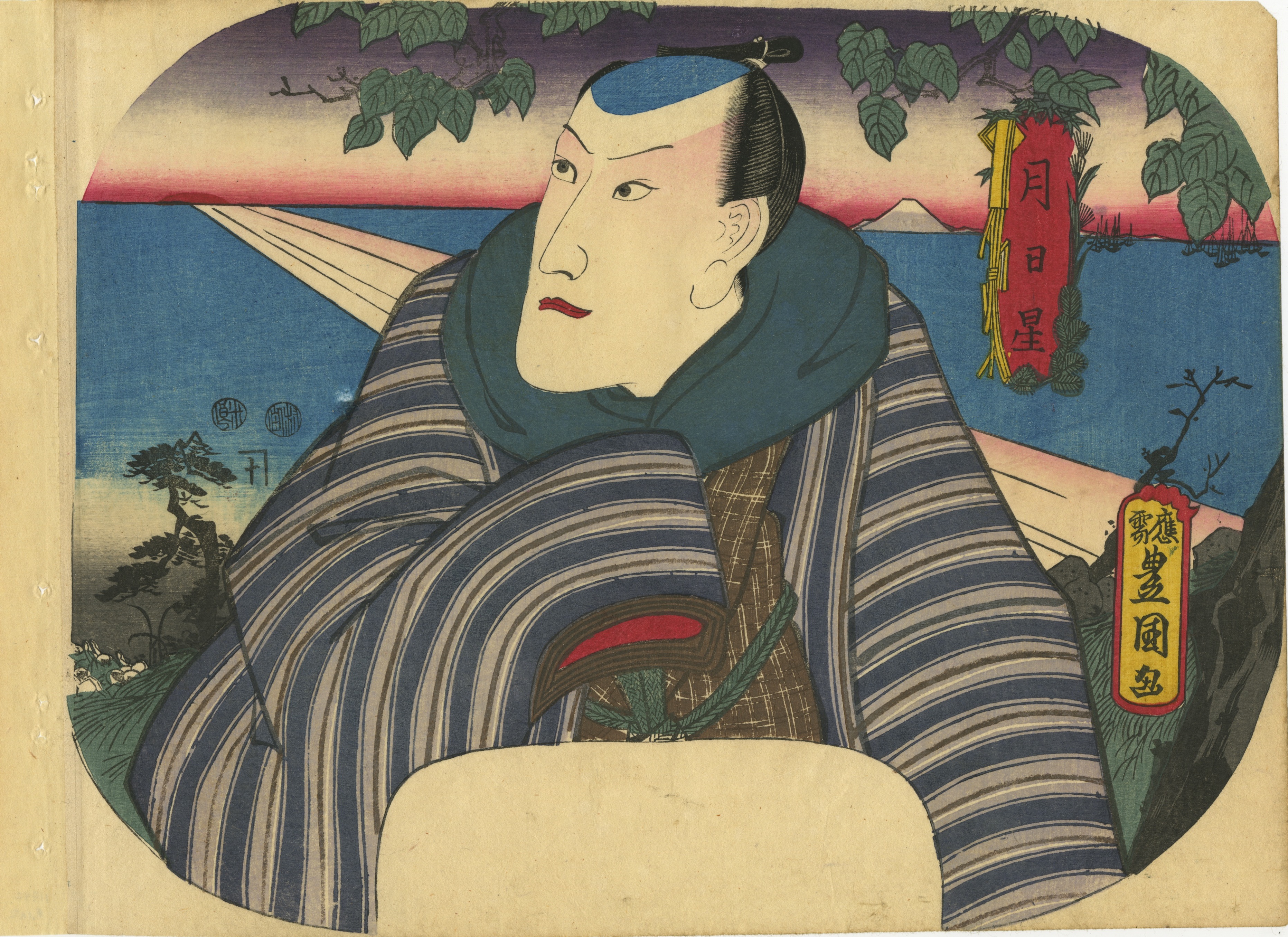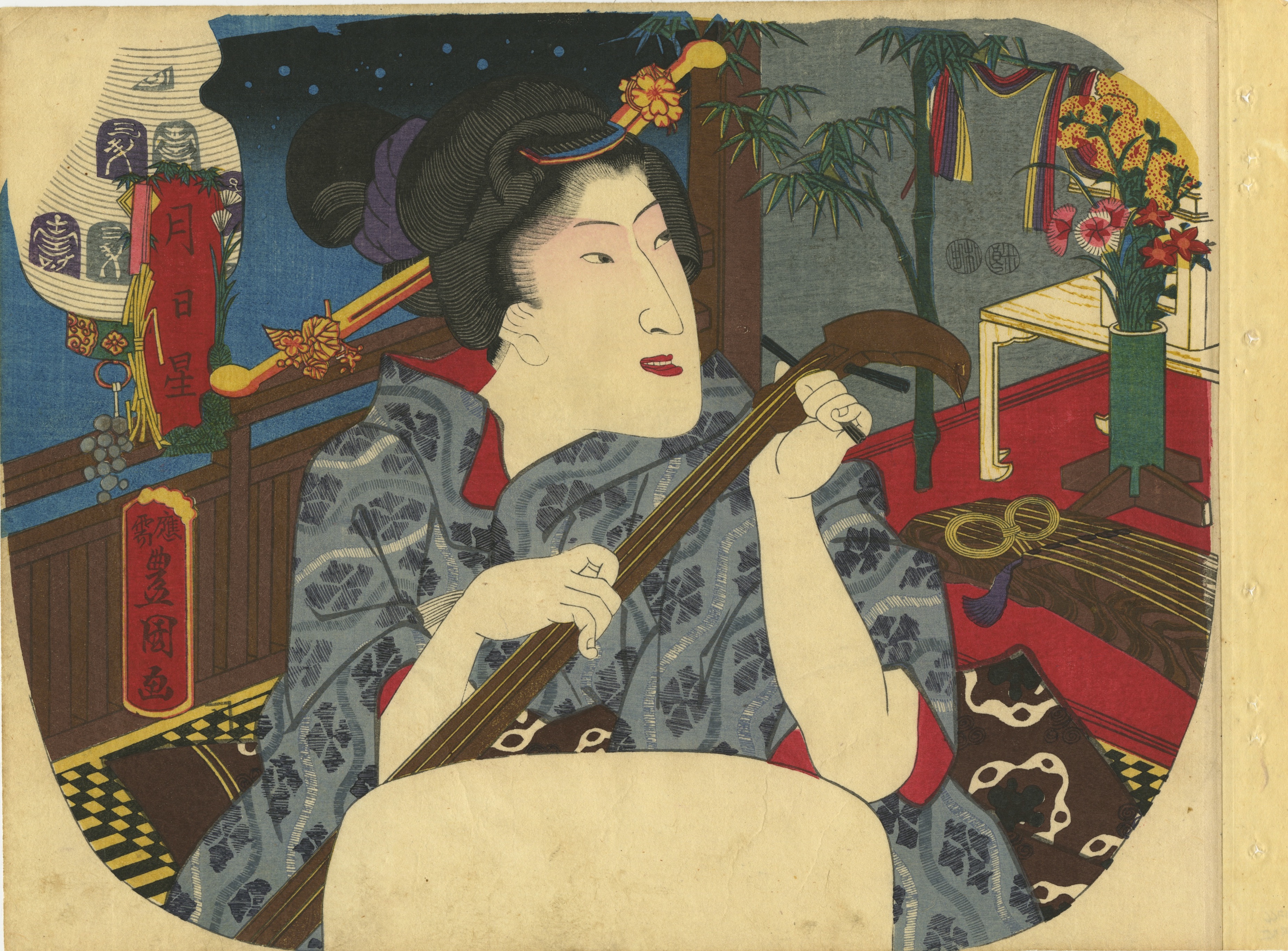-
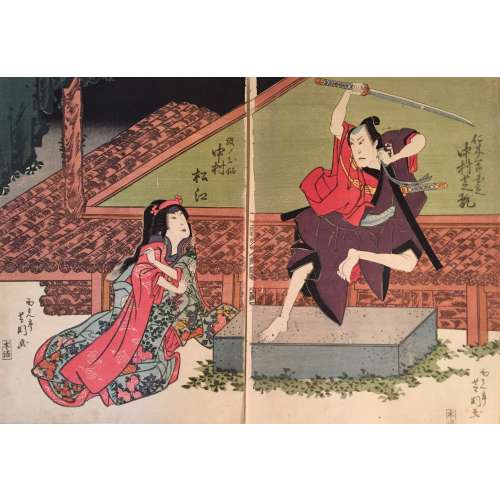 Saikotei Shibakuni (active 1821-1826). Osaka school. Play: Kinoshitakage Hazuma Gassen. Theatre: Nakamura-za /Naka-za (Osaka). Date: 7/1826. Horizontal oban diptych. SV: Nakamura Matsue III (Nakamura Tomijuro II) as female, Nakamura Utaemon III (Nakamura Shikan I) as a male. Publisher: Honya Seishichi [Marks 25-527 | 123f], Honsei, 1817-1838.
Saikotei Shibakuni (active 1821-1826). Osaka school. Play: Kinoshitakage Hazuma Gassen. Theatre: Nakamura-za /Naka-za (Osaka). Date: 7/1826. Horizontal oban diptych. SV: Nakamura Matsue III (Nakamura Tomijuro II) as female, Nakamura Utaemon III (Nakamura Shikan I) as a male. Publisher: Honya Seishichi [Marks 25-527 | 123f], Honsei, 1817-1838. -
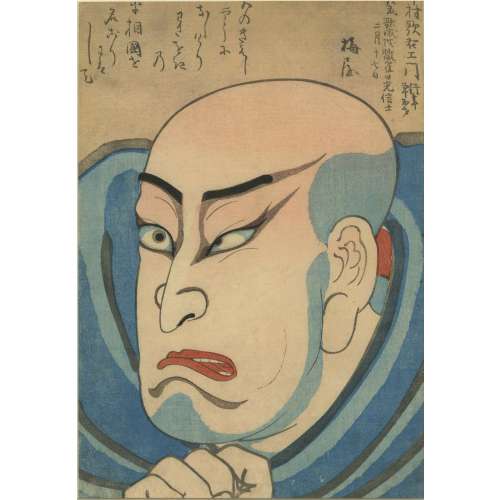 Utagawa Kuniyoshi (attributed to). Memorial portrait (Shini-e, death picture) of Nakamura Utaemon IV (a.k.a. Shikan II) as Taira no Kiyomori (1118-81). Date: 1852. Reference: [LIB-1030.2016] Robert Schaap. Heroes & ghosts: Japanese prints by Kuniyoshi, 1797-1861. — Leiden: Hotei Publishing, 1998; p. 165, image 176. [LIB-3316.2024] Chris Uhlenbeck, Jim Dwinger, Josephine Smit. The Riddles of Ukiyo-e: Women and Men in Japanese Prints. — Brussels: Ludion, 2023; pp. 242-3, № 119. Provenance: Herbert Egenolf Collection, Germany. Literature: Suzuki (1992) 317. Trimmed, unsigned.
Utagawa Kuniyoshi (attributed to). Memorial portrait (Shini-e, death picture) of Nakamura Utaemon IV (a.k.a. Shikan II) as Taira no Kiyomori (1118-81). Date: 1852. Reference: [LIB-1030.2016] Robert Schaap. Heroes & ghosts: Japanese prints by Kuniyoshi, 1797-1861. — Leiden: Hotei Publishing, 1998; p. 165, image 176. [LIB-3316.2024] Chris Uhlenbeck, Jim Dwinger, Josephine Smit. The Riddles of Ukiyo-e: Women and Men in Japanese Prints. — Brussels: Ludion, 2023; pp. 242-3, № 119. Provenance: Herbert Egenolf Collection, Germany. Literature: Suzuki (1992) 317. Trimmed, unsigned. -
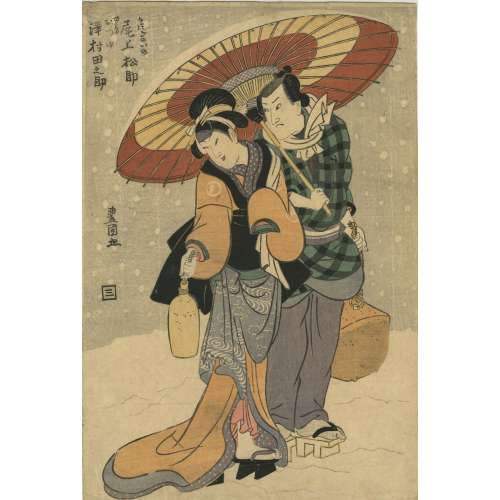 Utagawa Toyokuni (歌川豐國); 1769 – 24 February 1825. Actor Onoe Matsusuke II as Katsugiino (right), actor Sawamura Tanosuke II as Otsuyu (left) 尾上松助(二代目)in a role かつぎいの; 沢村田之助(二代目) in a role おつゆ. Play: "Yuki to Tsuki Hana no Kuronushi". Theater: Nakamura. Publisher: Mikawaua Seiemon (1805-1829) [Marks: 328]. Circa 1810.
Utagawa Toyokuni (歌川豐國); 1769 – 24 February 1825. Actor Onoe Matsusuke II as Katsugiino (right), actor Sawamura Tanosuke II as Otsuyu (left) 尾上松助(二代目)in a role かつぎいの; 沢村田之助(二代目) in a role おつゆ. Play: "Yuki to Tsuki Hana no Kuronushi". Theater: Nakamura. Publisher: Mikawaua Seiemon (1805-1829) [Marks: 328]. Circa 1810. -
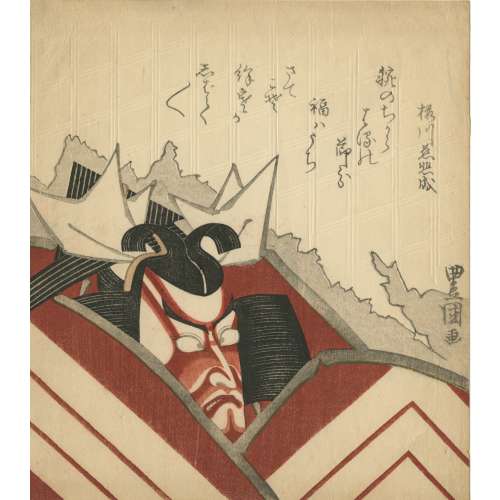 UTAGAWA TOYOKUNI I (1769–1825) Ichikawa Danjūrō VII (Ebizo V) in a shibaraku costume bursting through a paper screen. Surimono. Colour woodblock print: shikishiban, 8⅛ x 7⅛ in. (20.7 x 18.2 cm) Signed: Toyokuni ga Poem signed: Sakuragawa Jihinari Provenance: Sidney C. Ward
UTAGAWA TOYOKUNI I (1769–1825) Ichikawa Danjūrō VII (Ebizo V) in a shibaraku costume bursting through a paper screen. Surimono. Colour woodblock print: shikishiban, 8⅛ x 7⅛ in. (20.7 x 18.2 cm) Signed: Toyokuni ga Poem signed: Sakuragawa Jihinari Provenance: Sidney C. Ward -
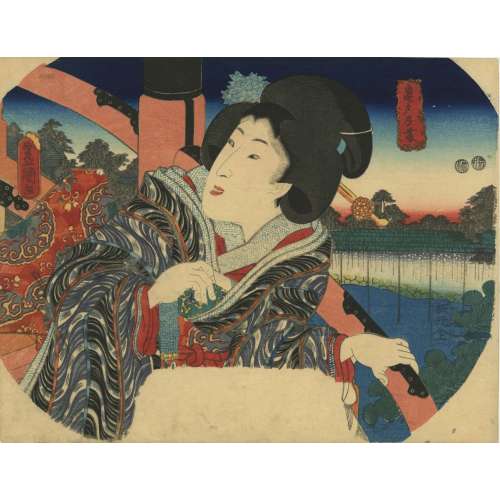 Artist: Utagawa Kunisada [歌川 国貞] a.k.a. Utagawa Toyokuni III [三代歌川豊国] (Japanese, 1786 – 1865). Signed: Toyokuni ga [豊国 画] in a red toshidama cartouche. Publisher: Iseya Sōemon [伊勢屋惣右衛門] (Japanese, c. 1776 – 1862), seal Marks 21-216. Double nanushi censor’s seals: Hama & Magome (1849-53). Title: Wisteria in Kameido [亀戸乃藤] (Kameido no fuji). An uncut fan print (uchiwa-e), depicting a young woman coming down Taikobashi bridge at Kameido Tenjin Shrine.
Artist: Utagawa Kunisada [歌川 国貞] a.k.a. Utagawa Toyokuni III [三代歌川豊国] (Japanese, 1786 – 1865). Signed: Toyokuni ga [豊国 画] in a red toshidama cartouche. Publisher: Iseya Sōemon [伊勢屋惣右衛門] (Japanese, c. 1776 – 1862), seal Marks 21-216. Double nanushi censor’s seals: Hama & Magome (1849-53). Title: Wisteria in Kameido [亀戸乃藤] (Kameido no fuji). An uncut fan print (uchiwa-e), depicting a young woman coming down Taikobashi bridge at Kameido Tenjin Shrine. -
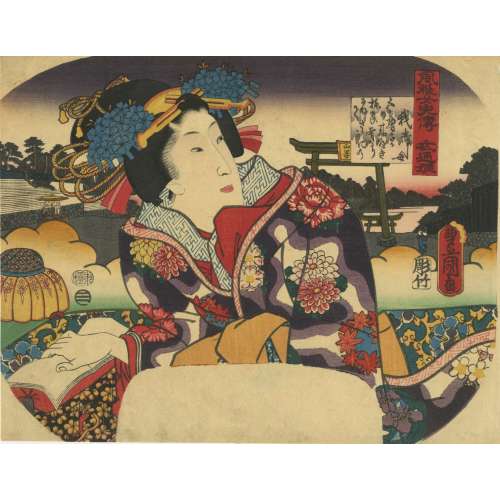 Artist: Utagawa Kunisada [歌川 国貞], a.k.a. Utagawa Toyokuni III [三代 歌川 豊国] (Japanese, 1786 – 1865). Signed: Toyokuni ga [豊国 画] in a red toshidama cartouche Block carver: Yokokawa Takejirō [横川竹二郎] (Japanese, fl. 1845 – 1863), seal: 彫竹 – hori Take. Publisher: Ibaya Senzaburō [伊場屋仙三郎] (Japanese, fl. c. 1845 – 1847). Media: Untrimmed fan print (uchiwa-e), 230 x 295 mm. Combined date seal and kiwame censor seal: Ansei 6 (1859). Title: Princess Sotoori [衣通姫] (Sotoori-hime) – Sotoori-hime was a concubine of Emperor Ingyo (reigned AD 412-53), and one of the Three Gods of Japanese Poetry [和歌三神] (Waka sanjin). Series: Chronicles of Elegant Women [風雅女史傳] (Fūga joshiden). The sign on the torii (Shinto shrine gates) reads: Mountain king shrine [山王宮] – it is the Sannō Shrine at the Nagata Riding Grounds in Edo. A print with these gates is at MFA (Boston) # 21.9853.
Artist: Utagawa Kunisada [歌川 国貞], a.k.a. Utagawa Toyokuni III [三代 歌川 豊国] (Japanese, 1786 – 1865). Signed: Toyokuni ga [豊国 画] in a red toshidama cartouche Block carver: Yokokawa Takejirō [横川竹二郎] (Japanese, fl. 1845 – 1863), seal: 彫竹 – hori Take. Publisher: Ibaya Senzaburō [伊場屋仙三郎] (Japanese, fl. c. 1845 – 1847). Media: Untrimmed fan print (uchiwa-e), 230 x 295 mm. Combined date seal and kiwame censor seal: Ansei 6 (1859). Title: Princess Sotoori [衣通姫] (Sotoori-hime) – Sotoori-hime was a concubine of Emperor Ingyo (reigned AD 412-53), and one of the Three Gods of Japanese Poetry [和歌三神] (Waka sanjin). Series: Chronicles of Elegant Women [風雅女史傳] (Fūga joshiden). The sign on the torii (Shinto shrine gates) reads: Mountain king shrine [山王宮] – it is the Sannō Shrine at the Nagata Riding Grounds in Edo. A print with these gates is at MFA (Boston) # 21.9853.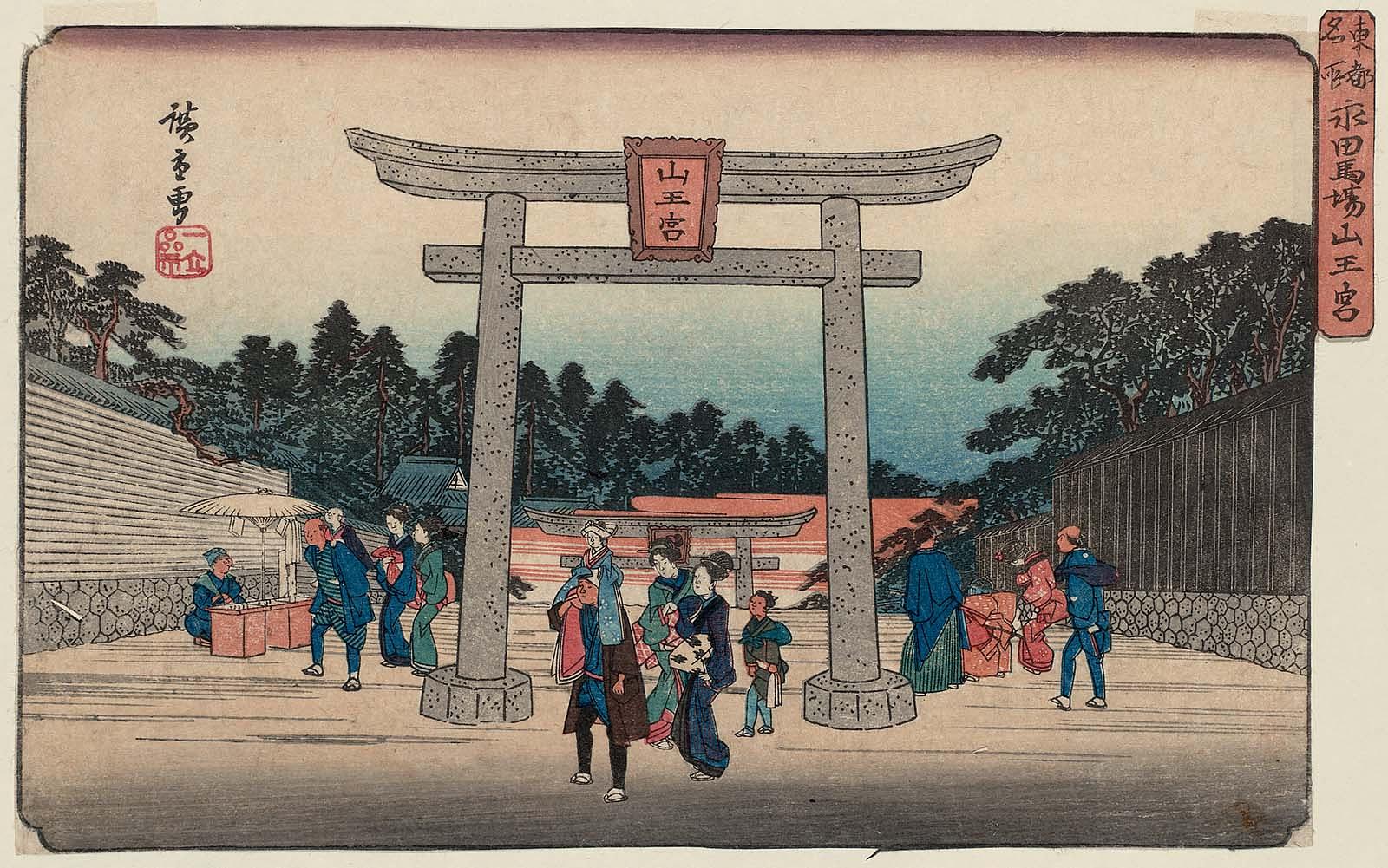 Other prints from the same series in this collection:
SVJP-0343.2021 — Tamagiku:
Other prints from the same series in this collection:
SVJP-0343.2021 — Tamagiku:
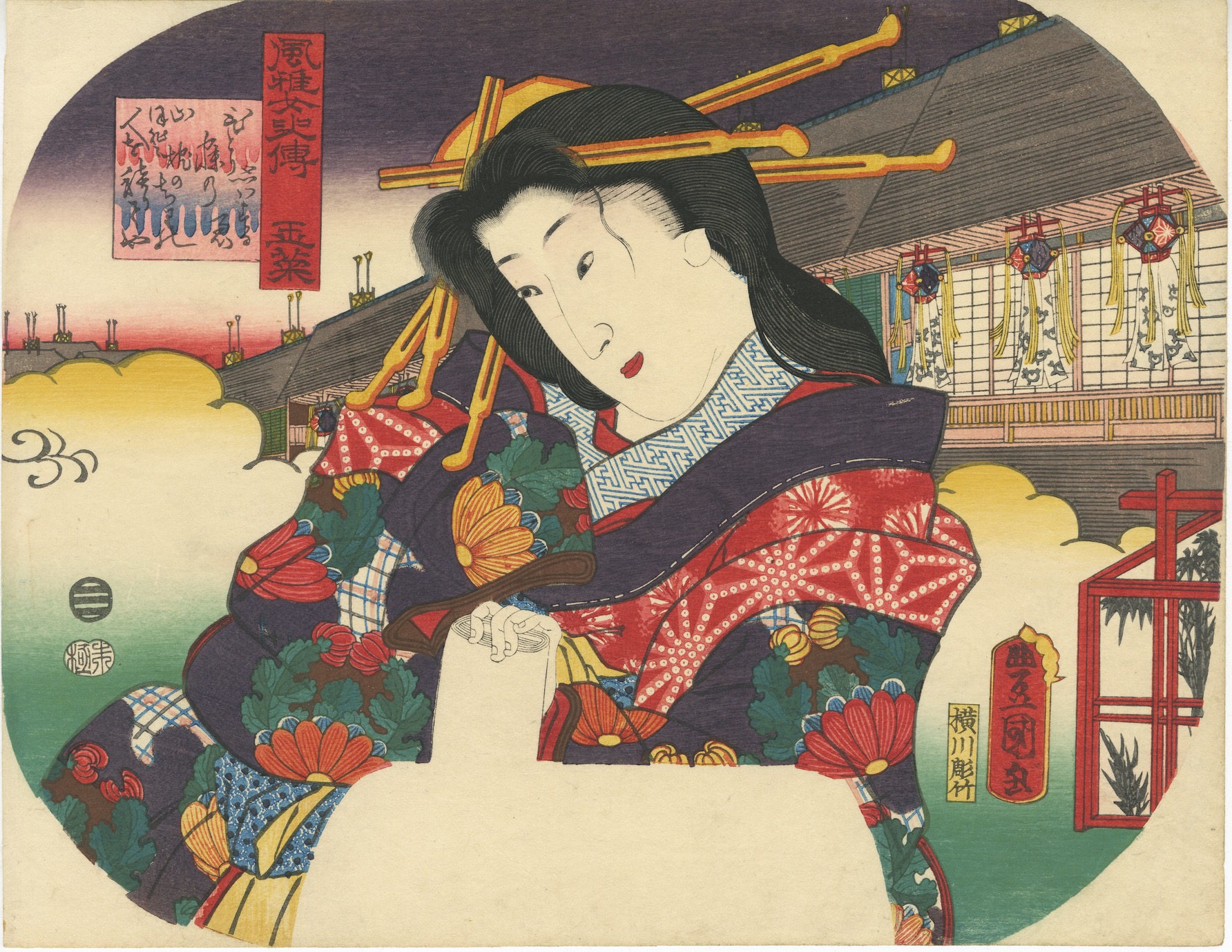 SVJP-0400.2023 — Saiko:
SVJP-0400.2023 — Saiko:
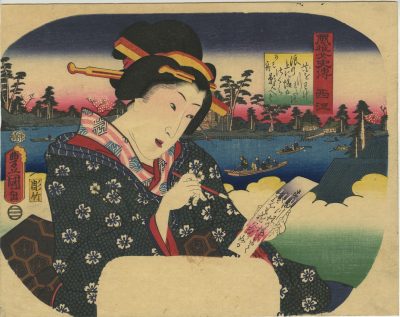 Note: Special thanks to Horst Graebner, who helped decipher and understand the meaning.
Note: Special thanks to Horst Graebner, who helped decipher and understand the meaning.
-
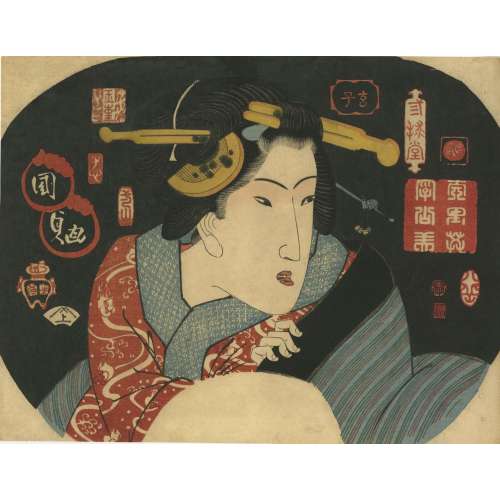 Artist: Utagawa Kunisada [歌川 国貞] a.k.a. Utagawa Toyokuni III [三代歌川豊国] (Japanese, 1786 – 1865). Publisher: Iseya Sōemon [伊勢屋惣右衛門] (Japanese, c. 1776 – 1862). Signed: Kunisada ga within a double toshidama. Date-kiwame seals: Bunsei 11 (1828).
Artist: Utagawa Kunisada [歌川 国貞] a.k.a. Utagawa Toyokuni III [三代歌川豊国] (Japanese, 1786 – 1865). Publisher: Iseya Sōemon [伊勢屋惣右衛門] (Japanese, c. 1776 – 1862). Signed: Kunisada ga within a double toshidama. Date-kiwame seals: Bunsei 11 (1828). -
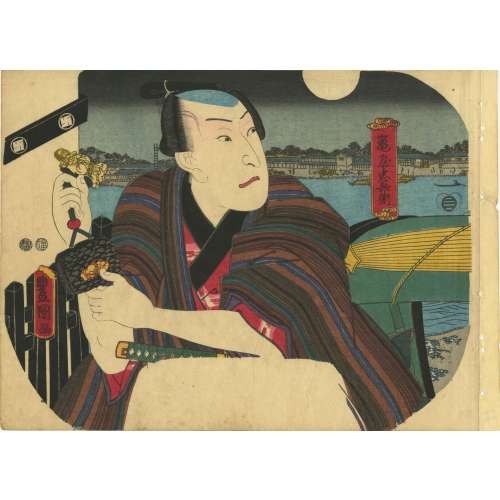 Artist: Utagawa Kunisada [歌川 国貞] a.k.a. Utagawa Toyokuni III [三代歌川豊国] (Japanese, 1786 – 1865). Signed: Toyokuni ga [豊国 画] in a red toshidama cartouche. Actor: Sawamura Gennosuke II [沢村源之助] (Japanese, 1802/7 – 1853); other names: Suketakaya Takasuke III, Sawamura Chōjūrō V [沢村長十郎], Sawamura Tosshō I, Sawamura Genpei I. Character: Kameya Chubei [亀屋忠兵衛] Play: Koi Bikyaku Yamato Orai [恋飛脚大和往来] Performance: Kawarasaki Theatre [河原崎座] in the 2nd month of 1851. Double nanushi censor seals: Fuku & Muramatsu, from 3rd month of Kaei 2 to 11th month of Kaei 4 (1849-51). Another fan print from the pair SVJP-0212-1.2016: Ichikawa Ebizō V as Tanbaya Onizo / Fan print, 1851.
Artist: Utagawa Kunisada [歌川 国貞] a.k.a. Utagawa Toyokuni III [三代歌川豊国] (Japanese, 1786 – 1865). Signed: Toyokuni ga [豊国 画] in a red toshidama cartouche. Actor: Sawamura Gennosuke II [沢村源之助] (Japanese, 1802/7 – 1853); other names: Suketakaya Takasuke III, Sawamura Chōjūrō V [沢村長十郎], Sawamura Tosshō I, Sawamura Genpei I. Character: Kameya Chubei [亀屋忠兵衛] Play: Koi Bikyaku Yamato Orai [恋飛脚大和往来] Performance: Kawarasaki Theatre [河原崎座] in the 2nd month of 1851. Double nanushi censor seals: Fuku & Muramatsu, from 3rd month of Kaei 2 to 11th month of Kaei 4 (1849-51). Another fan print from the pair SVJP-0212-1.2016: Ichikawa Ebizō V as Tanbaya Onizo / Fan print, 1851.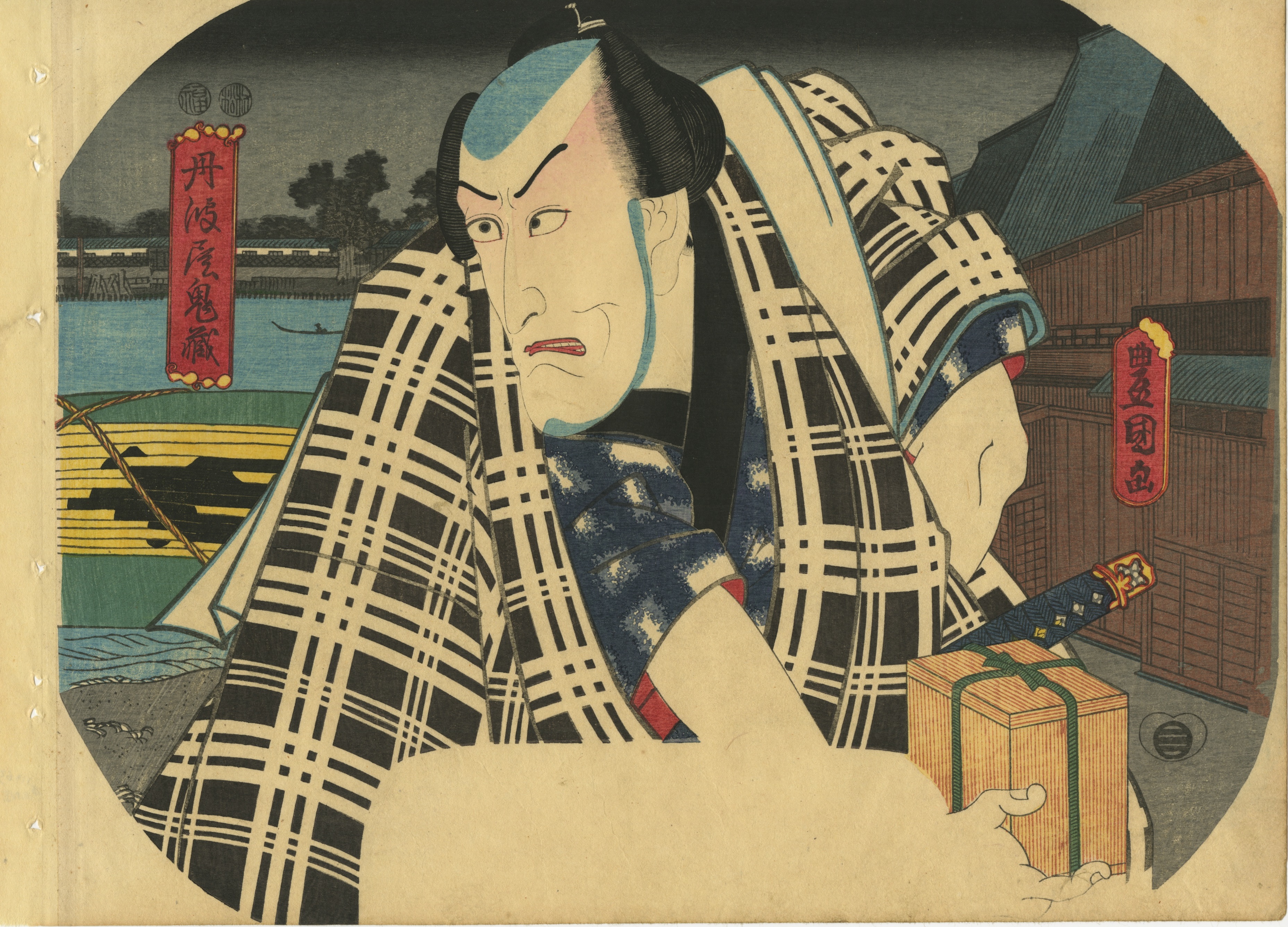
-
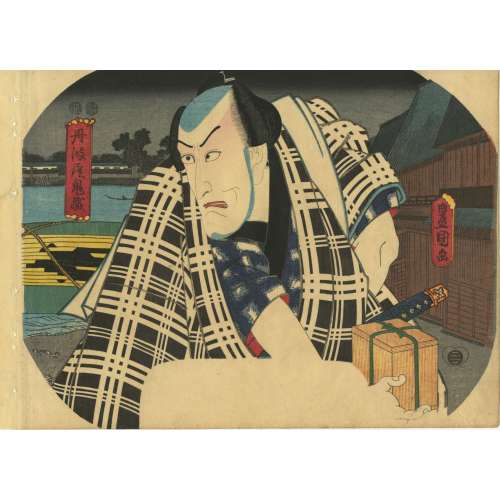 Artist: Utagawa Kunisada [歌川 国貞] a.k.a. Utagawa Toyokuni III [三代歌川豊国] (Japanese, 1786 – 1865). Signed: Toyokuni ga [豊国 画] in a red toshidama cartouche. Actor: Ichikawa Danjūrō VII 市川団十郎 (Japanese, 1791 – 1859); other names: Ichikawa Ebizō V, Ichikawa Hakuen II, Ichikawa Shinnosuke I. Character: Tanbaya Onizo [丹波屋鬼蔵] Play: Koi Bikyaku Yamato Orai [恋飛脚大和往来] Performance: Kawarasaki Theatre [河原崎座] in the 2nd month of 1851. Double nanushi censor seals: Fuku & Muramatsu, from 3rd month of Kaei 2 to 11th month of Kaei 4 (1849-51). Another fan print from the pair SVJP-0212-2.2016: Sawamura Chōjūrō V as Kameya Chubei.
Artist: Utagawa Kunisada [歌川 国貞] a.k.a. Utagawa Toyokuni III [三代歌川豊国] (Japanese, 1786 – 1865). Signed: Toyokuni ga [豊国 画] in a red toshidama cartouche. Actor: Ichikawa Danjūrō VII 市川団十郎 (Japanese, 1791 – 1859); other names: Ichikawa Ebizō V, Ichikawa Hakuen II, Ichikawa Shinnosuke I. Character: Tanbaya Onizo [丹波屋鬼蔵] Play: Koi Bikyaku Yamato Orai [恋飛脚大和往来] Performance: Kawarasaki Theatre [河原崎座] in the 2nd month of 1851. Double nanushi censor seals: Fuku & Muramatsu, from 3rd month of Kaei 2 to 11th month of Kaei 4 (1849-51). Another fan print from the pair SVJP-0212-2.2016: Sawamura Chōjūrō V as Kameya Chubei.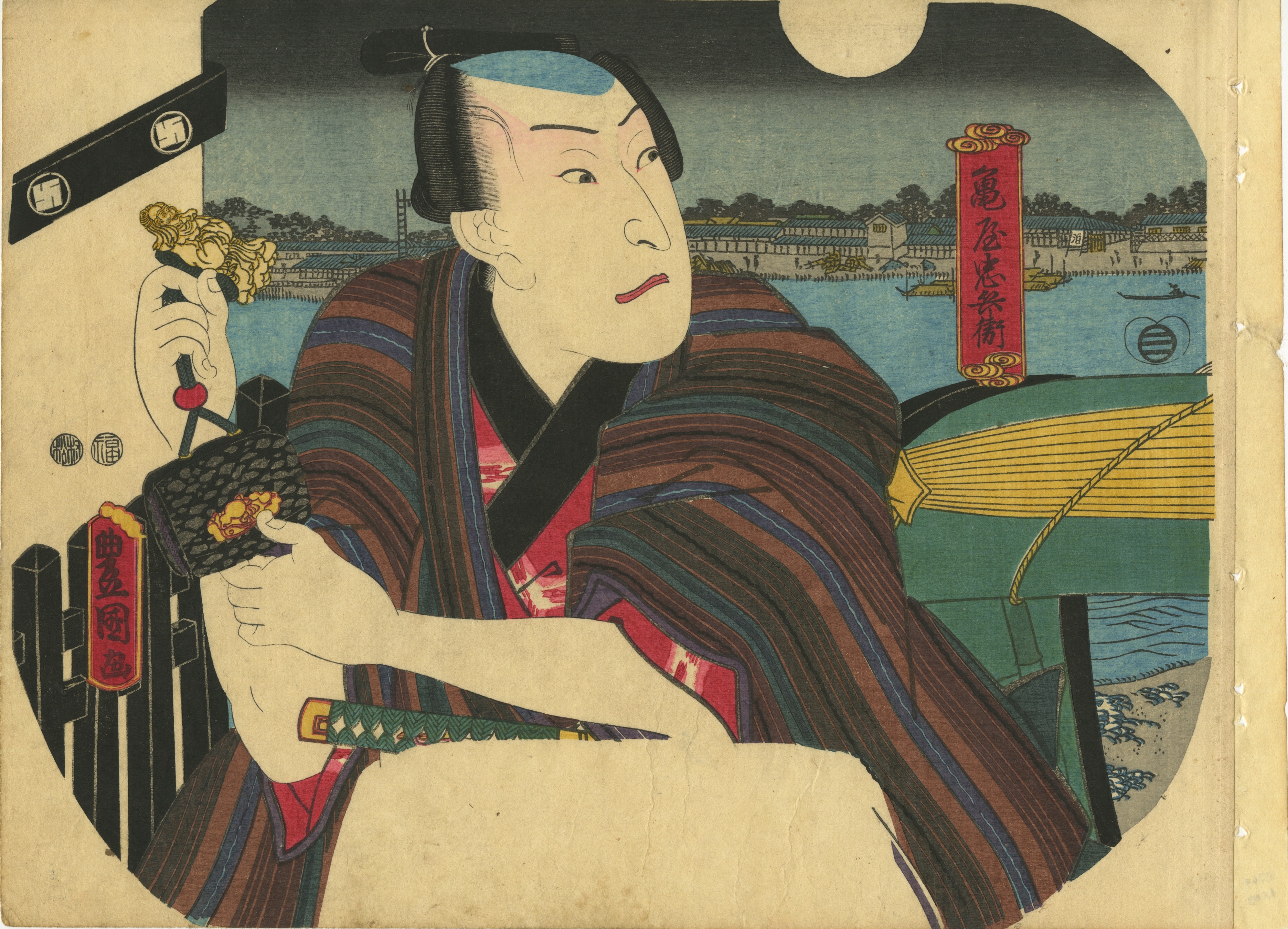
-
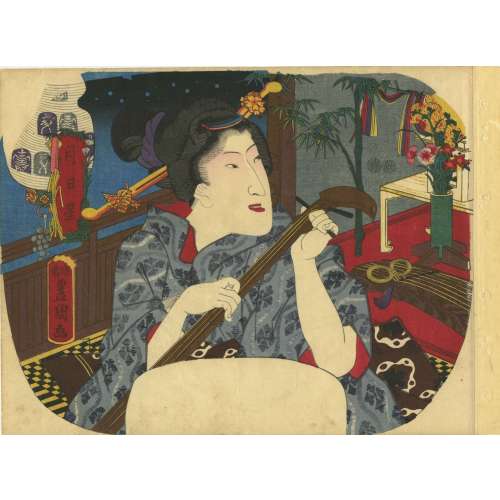 Artist: Utagawa Kunisada [歌川 国貞] a.k.a. Utagawa Toyokuni III [三代歌川豊国] (Japanese, 1786 – 1865). Signed: Ōju Toyokuni ga [応需豊国画], in a toshidama cartouche. Double nanushi censor seals: Mera & Murata (1846-50). Publisher: Kojimaya Jūbei [小嶋屋重兵衛] (Japanese, fl. c. 1797 – 1869). A beautiful woman, possibly a kabuki actor Iwai Hanshirō VIII [岩井半四郎] (Iwai Shijaku II, Iwai Kumesaburō III [岩井粂三郎], Iwai Hisajirō II, Japanese, 1829 – 1882), tuning the samisen on a veranda under the shining stars. The complete set of series Moon, Sun, Stars [月日星] (tsuki-hi-hoshi/boshi), three sources of light (sankō) [三光]:
Artist: Utagawa Kunisada [歌川 国貞] a.k.a. Utagawa Toyokuni III [三代歌川豊国] (Japanese, 1786 – 1865). Signed: Ōju Toyokuni ga [応需豊国画], in a toshidama cartouche. Double nanushi censor seals: Mera & Murata (1846-50). Publisher: Kojimaya Jūbei [小嶋屋重兵衛] (Japanese, fl. c. 1797 – 1869). A beautiful woman, possibly a kabuki actor Iwai Hanshirō VIII [岩井半四郎] (Iwai Shijaku II, Iwai Kumesaburō III [岩井粂三郎], Iwai Hisajirō II, Japanese, 1829 – 1882), tuning the samisen on a veranda under the shining stars. The complete set of series Moon, Sun, Stars [月日星] (tsuki-hi-hoshi/boshi), three sources of light (sankō) [三光]: -
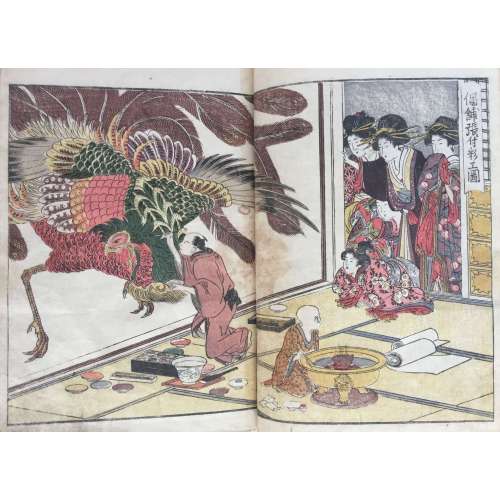 Seiro ehon nenju gyoji 青楼絵本年中行事 (A Picture Book of Annual Events in Yoshiwara). Block cut by: Fuji Kazumune (藤一宗). Printed by: Jakushodo Toemon (霍松堂藤右衛門). Written by: Jippensha Ikku (十返舎一九) (text, kyoka 4 & 12). Published by: Kazusaya Chusuke (上総屋忠助). Print artist: Kitagawa Utamaro (喜多川歌麿). Written by: Sandara Boshi (三陀羅法師) (kyoka 1). Workshop of: Yashiki no Katamaru (屋職堅丸). 1804 (spring); Edo. Reference: British Museum; Fine Arts Museums of San Francisco.
Seiro ehon nenju gyoji 青楼絵本年中行事 (A Picture Book of Annual Events in Yoshiwara). Block cut by: Fuji Kazumune (藤一宗). Printed by: Jakushodo Toemon (霍松堂藤右衛門). Written by: Jippensha Ikku (十返舎一九) (text, kyoka 4 & 12). Published by: Kazusaya Chusuke (上総屋忠助). Print artist: Kitagawa Utamaro (喜多川歌麿). Written by: Sandara Boshi (三陀羅法師) (kyoka 1). Workshop of: Yashiki no Katamaru (屋職堅丸). 1804 (spring); Edo. Reference: British Museum; Fine Arts Museums of San Francisco. -
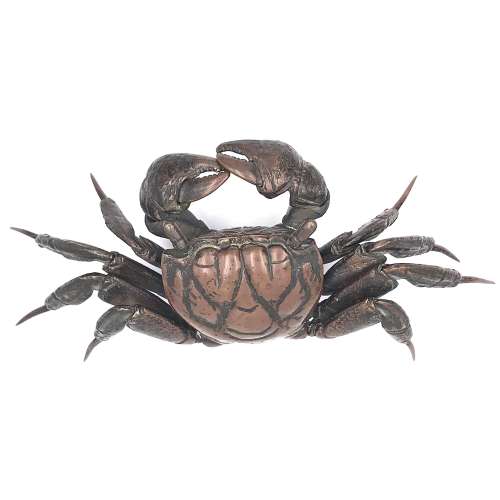 Jizai okimono bronze articulated model of a crab. Japan, Meiji period(1868-1912). Size: Body: 6.5 x 6 cm. Total: 23 x 11 cm. Weight: 762 g
Jizai okimono bronze articulated model of a crab. Japan, Meiji period(1868-1912). Size: Body: 6.5 x 6 cm. Total: 23 x 11 cm. Weight: 762 g -
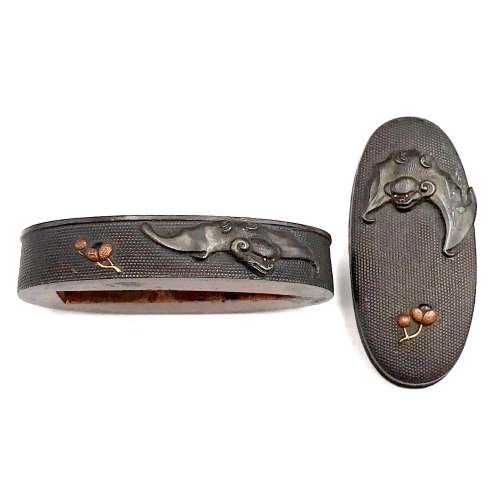
Fuchi-kashira made of shakudō carved and inlaid with gold and red copper with the design of a bat and a fruit (persimmon?). Nanako surface.
Fuchi: 37 x 19 x 7 mm. Kashira: 34 x 16 x 5 mm. Main material: shakudō. Other metals: gold and copper. Surface treatment: nanako-ji. -
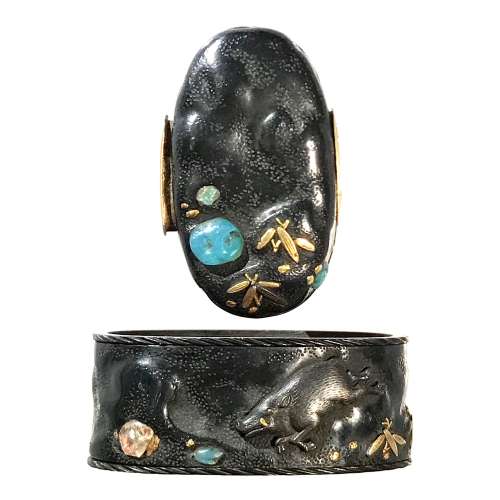 Signature: Unsigned
Signature: UnsignedFuchi-kashira with rock and boar (iwa ni inoshishi zu) motif. Inlay of precious stones or colour glass. Shakudō, gold, gemstones. Technique: Sukibori zogan kiniroe.
Fuchi: 36 x 21 x 14 mm; Weight: 22 g; Kashira: 32 x 17 x 5 mm; Weight: 8 g; Material : Shakudō; Gold; Gemstones (Chalcedony and Rose Quartz). Possibly, Owari school. -
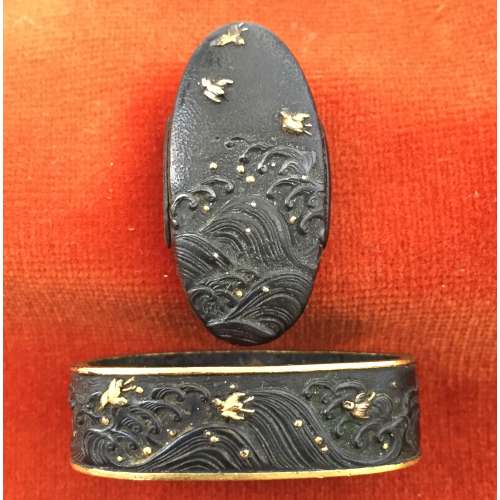 Fuchi: 37 x 21 x 11 mm; Weight: 13 g Kashira: 34 x 16 x 6 mm ; Weight: 10 g Material : Shakudo; Gold. Signature: Unsigned Technique: Sunameji Sukibori Zogan Decoration: Nami Chidori zu (wave & plover)
Fuchi: 37 x 21 x 11 mm; Weight: 13 g Kashira: 34 x 16 x 6 mm ; Weight: 10 g Material : Shakudo; Gold. Signature: Unsigned Technique: Sunameji Sukibori Zogan Decoration: Nami Chidori zu (wave & plover) -
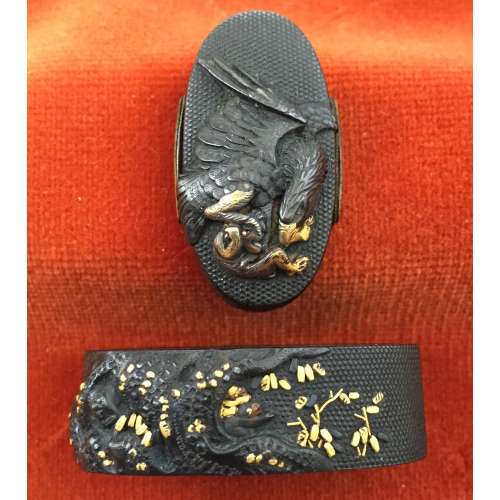 Fuchi: 38 x 22 x 12 mm. Kashira: 32 x 17 x 11 mm Main material: shakudo; surface treatment: nanako-ji; other metals: gold, shibuichi and copper; decorative technique: iroe takazogan. Signed: Nyudo Jounishi 人道 乗西 (possibly)
Fuchi: 38 x 22 x 12 mm. Kashira: 32 x 17 x 11 mm Main material: shakudo; surface treatment: nanako-ji; other metals: gold, shibuichi and copper; decorative technique: iroe takazogan. Signed: Nyudo Jounishi 人道 乗西 (possibly) -
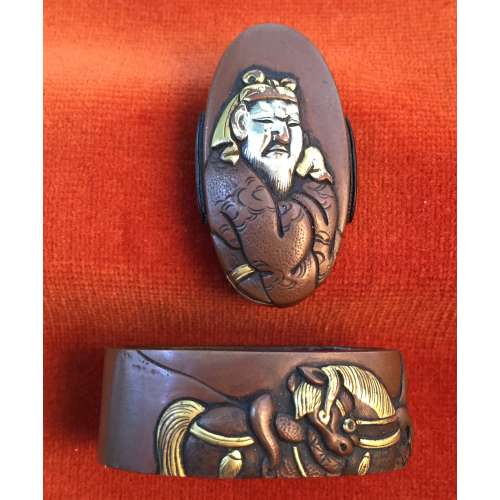 Fuchi: 38 x 22 x 14 mm. Kashira: 33 x 18 x 9 mm Techniques: Usu-shishiai-bori (薄肉合彫) – low-relief, zogan.
Fuchi: 38 x 22 x 14 mm. Kashira: 33 x 18 x 9 mm Techniques: Usu-shishiai-bori (薄肉合彫) – low-relief, zogan. -
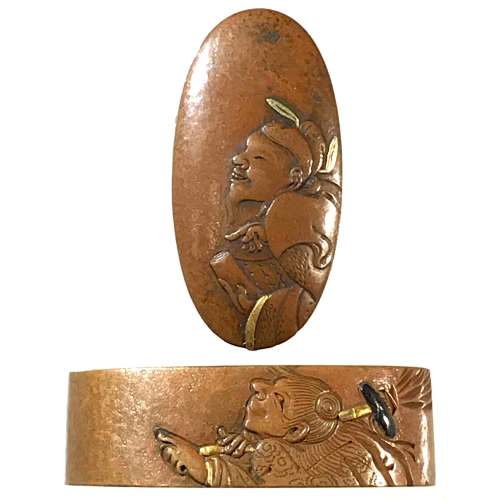 Fuchi-kashira of copper, carved and inlaid with gold and shakudō, with the design of Kanzan (on kashira), Chinese: Hanshan, an eccentric poet of the Tang dynasty with a scroll (618-906) who befriended Jittoku (on fuchi, Chinese: Shide, a kitchen helper at a mountain temple, holding a broom). Fuchi is signed Josui (如⽔). Fuchi (Jittoku, holding a broom): 38 x 22 x 12 mm. Weight: 23g (Nakago hole: 27 x 8.5 mm); Kashira (Kanzan, reading a scroll): 34 x 17 x 9 mm. Weight: 10g. Materials: Copper, gold, shakudō. Techniques: Tsuchi-me-ji (hammer-marked surface); usu-shishiai-bori or usuniku-bori (low-relief carving which leaves the image somewhat higher than the surface - high relief effect); zōgan (inlay). Josui was a daughter of Jochiku Kamo (Markus Sesko, Genealogies).
Fuchi-kashira of copper, carved and inlaid with gold and shakudō, with the design of Kanzan (on kashira), Chinese: Hanshan, an eccentric poet of the Tang dynasty with a scroll (618-906) who befriended Jittoku (on fuchi, Chinese: Shide, a kitchen helper at a mountain temple, holding a broom). Fuchi is signed Josui (如⽔). Fuchi (Jittoku, holding a broom): 38 x 22 x 12 mm. Weight: 23g (Nakago hole: 27 x 8.5 mm); Kashira (Kanzan, reading a scroll): 34 x 17 x 9 mm. Weight: 10g. Materials: Copper, gold, shakudō. Techniques: Tsuchi-me-ji (hammer-marked surface); usu-shishiai-bori or usuniku-bori (low-relief carving which leaves the image somewhat higher than the surface - high relief effect); zōgan (inlay). Josui was a daughter of Jochiku Kamo (Markus Sesko, Genealogies). -
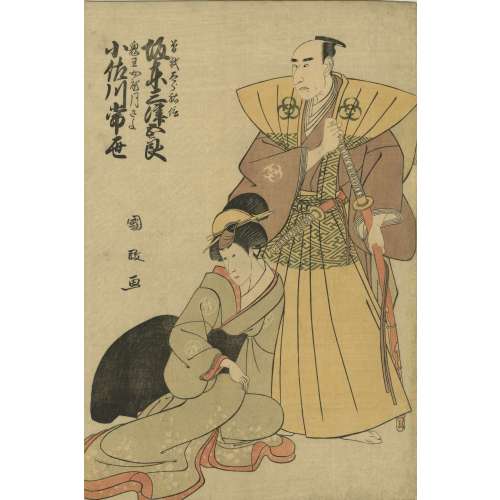 Bando Mitsugoro II as Soga no Taro Sukenobu, the step-father of the Soga brothers, and Osagawa Tsuneyo II as Onio's wife Tsukisayo, in the play 'Omonbi Kuruwa Soga' performed at the Ichimura-za in the 1st month of 1799. Reference: Harvard Art Museums accession number 1933.4.525. Publications: Narazaki Muneshige, Ukiyo-e shuka [Collection of the Masterpieces of Ukiyo-e Prints in Museums] Volume 8: Foggu Bijutsukan [Fogg Art Museum, Harvard University], Neruson Bijutsukan [Nelson Atkins Museum]..., Shogaku-kan (Tokyo, Japan, 1980 [Showa 55]), Color Plate 107; p. 104 (entry p. 191). SOLD
Bando Mitsugoro II as Soga no Taro Sukenobu, the step-father of the Soga brothers, and Osagawa Tsuneyo II as Onio's wife Tsukisayo, in the play 'Omonbi Kuruwa Soga' performed at the Ichimura-za in the 1st month of 1799. Reference: Harvard Art Museums accession number 1933.4.525. Publications: Narazaki Muneshige, Ukiyo-e shuka [Collection of the Masterpieces of Ukiyo-e Prints in Museums] Volume 8: Foggu Bijutsukan [Fogg Art Museum, Harvard University], Neruson Bijutsukan [Nelson Atkins Museum]..., Shogaku-kan (Tokyo, Japan, 1980 [Showa 55]), Color Plate 107; p. 104 (entry p. 191). SOLD -
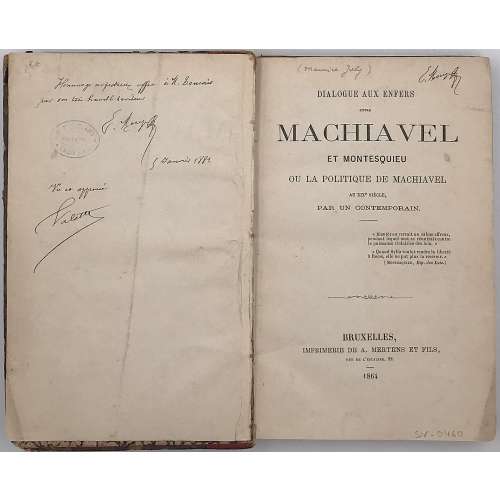 Title page: DIALOGUE AUX ENFERS | ENTRE | MACHIAVEL | ET MONTESQUIEU | OU LA POLITIQUE DE MACHIAVEL | AU XIXe SIÈCLE, | PAR UN CONTEMPORAIN. | {6 lines of citations} | ~ | BRUXELLES, | IMPRIMERIE DE A. MERTENS ET FILS, | RUE DE L’ESCALIER, 22. | 1864 ||
Title page: DIALOGUE AUX ENFERS | ENTRE | MACHIAVEL | ET MONTESQUIEU | OU LA POLITIQUE DE MACHIAVEL | AU XIXe SIÈCLE, | PAR UN CONTEMPORAIN. | {6 lines of citations} | ~ | BRUXELLES, | IMPRIMERIE DE A. MERTENS ET FILS, | RUE DE L’ESCALIER, 22. | 1864 ||Description: 17.9 x 12 cm, quarter red morocco over marbled boards, spine with raised bands, gilt bees in compartments, gilt lettering, marbled endpapers, ffep cut out top 1/4, ffep and h.t. loose.
Collation: 12mo; fep, π4 1-2712, 292, fep.; total 174 leaves. Pagination: [2 h.t] [2 t.p.] [i] ii-iii [iv] [1] 2-337 [338] [2 errata].Inscriptions and markings: "Hommage respectueux offert à M. Bourdais par son très humble serviteur, 5 Janvier 1881". Signature: E. Rouger (?) "Vu et approuvé". "Valatte". Ink stamp: "M<aîtr>e E. Brouard - Notaire a Laon Aisne".
Other copies: LIB-1034.2016 and LIB-2913.2021. Other related objects: SVVP-0062.2021. The publication was funded by the author and smuggled into France. Contributors: Maurice Joly (French, 1829 – 1878) -
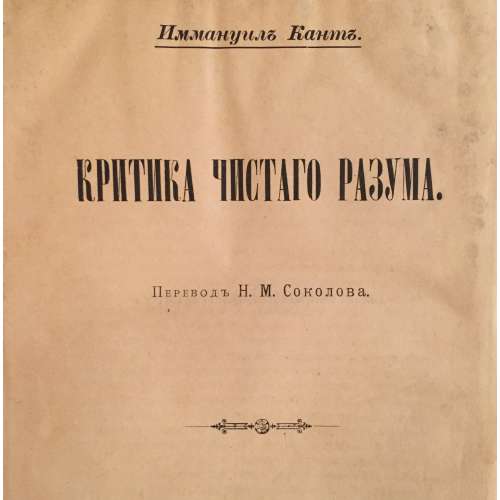 Иммануил Кант. Критика чистого разума. Пер. Н. М. Соколова. С.-Петербург. Издание книжного магазина М. В. Попова, 1897. - 674 с.
Иммануил Кант. Критика чистого разума. Пер. Н. М. Соколова. С.-Петербург. Издание книжного магазина М. В. Попова, 1897. - 674 с. -

Конфуциева летопись. Чунь-Цю. (Весна и осень) Перевод Н. Монастырева. (С литографированными примечаниями). С.-Петербург, Тип. бр. Пантелеевых, 1876. 107 с. Тир. 600 экз.
Примечания отсутствуют. Не разрезана.
-

Жуковский Ю. Г. Политические и общественные теории XVI-го века. - С.Петербург, 1866. Типография А. Головачева. // Материалы для общественной науки. - 163 с.
Схоластика.
Макиавелли и Томас Мор.
Реформация: Лютер, Кальвин, анабаптисты.
Жан Боден.
[Штамп на титуле: A. Namoradze, Tiflis. 1935.]
-

Поль Дельтуф. Жизнь и творения Макиавелли. // "Записки для чтения, издаваемые К. Трубниковым", 1867, NN 8-9, с. 73-77. Ежемесячное приложение к Биржевым ведомостям. Август и Сентябрь. Санктпетербург. Тип. Товарищества "Общественная польза".
"Essai sur les oeuvres et la doctrine de Machiavel, avec la traduction littérale du Prince et de quelques fragments historiques et littéraires", par Paul Deltuf, Paris, 1867.
-

Макиавелли Николай. Государь (Il Principe) и Рассуждения на первые три книги Тита Ливия. Пер. c итал. Н. Курочкина. Издание "Русской книжной торговли". - СПб.; тип. Тиблена и Ко. (Неклюдова), 1869. - 502 стр.
-
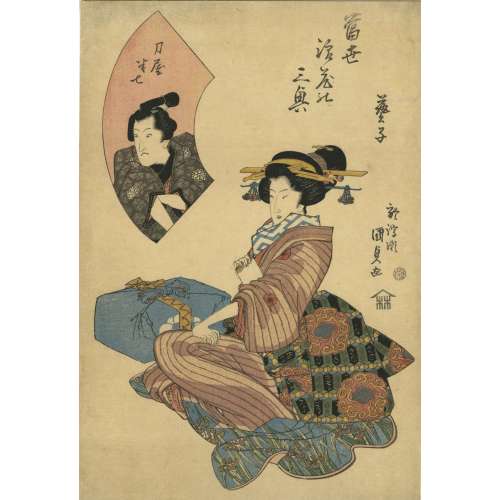 The right sheet of (optional) triptych: Geisha (Geiko) and kabuki actor Iwai Hanshirō V as Katanaya Hanshichi from Three pleasures of present-day Osaka (Tōsei Naniwa no sankō)「当世浪花の三興 芸子」 「刀屋半七」五代目岩井半四郎. Publisher: Iseya Rihei [伊勢屋利兵衛] (Japanese, fl. 1790s – c. 1879) Year: 1821 (Bunsei 4). Size: Vertical ōban; 36.5 x 25.2 cm. Signed: 於浮瀬亭国貞画 – Drawn by Kunisada in Ukabuse (Ukabuse ni oite Kunisada ga). Ukabuse is the name of a famous restaurant in Osaka, this signature can be found only on a three print bijin series [Kunisada Project]. Censor's seal: kiwame 改印:極 Actor Iwai Hanshirō V [岩井半四郎] (Japanese, 1776 – 1847); other names: Iwai Tojaku, Iwai Kumesaburō I. Character: Katanaya Hanshichi [刀屋半七] Ref: MFA ACCESSION NUMBER 11.21938; LIB-2967.2022 Izzard. Full series (triptych) Three Pleasures of Present-day Osaka (Tōsei Naniwa no sankō):
The right sheet of (optional) triptych: Geisha (Geiko) and kabuki actor Iwai Hanshirō V as Katanaya Hanshichi from Three pleasures of present-day Osaka (Tōsei Naniwa no sankō)「当世浪花の三興 芸子」 「刀屋半七」五代目岩井半四郎. Publisher: Iseya Rihei [伊勢屋利兵衛] (Japanese, fl. 1790s – c. 1879) Year: 1821 (Bunsei 4). Size: Vertical ōban; 36.5 x 25.2 cm. Signed: 於浮瀬亭国貞画 – Drawn by Kunisada in Ukabuse (Ukabuse ni oite Kunisada ga). Ukabuse is the name of a famous restaurant in Osaka, this signature can be found only on a three print bijin series [Kunisada Project]. Censor's seal: kiwame 改印:極 Actor Iwai Hanshirō V [岩井半四郎] (Japanese, 1776 – 1847); other names: Iwai Tojaku, Iwai Kumesaburō I. Character: Katanaya Hanshichi [刀屋半七] Ref: MFA ACCESSION NUMBER 11.21938; LIB-2967.2022 Izzard. Full series (triptych) Three Pleasures of Present-day Osaka (Tōsei Naniwa no sankō):





